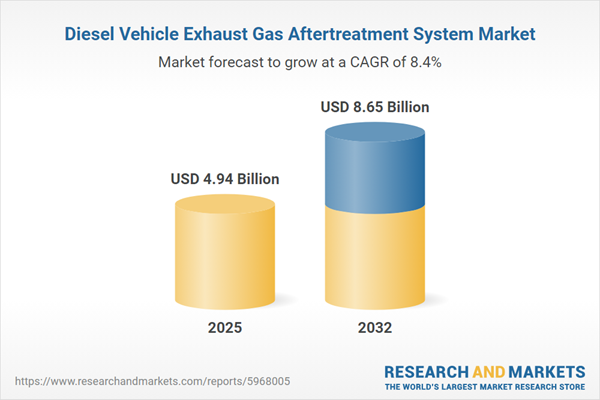Speak directly to the analyst to clarify any post sales queries you may have.
As global emissions policies evolve, senior leaders face increasing pressure to maintain compliance and optimize fleet operations—making advanced diesel vehicle exhaust gas aftertreatment systems essential for forward-thinking organizations.
Market Snapshot: Diesel Vehicle Exhaust Gas Aftertreatment System Market
The diesel vehicle exhaust gas aftertreatment system market is entering a phase of robust growth, currently valued at USD 4.55 billion in 2024 and projected to reach USD 4.94 billion by 2025, with an expected compound annual growth rate of 8.35% through 2032. This growth stems from stricter global emissions standards, compelling fleet operators, manufacturers, and logistics providers to adopt new catalyst and filtration technologies for regulatory compliance and reliable performance. Companies are progressing toward digital monitoring, modular systems, and seamless technology integration to address diverse needs across all classes of vehicles. Rapid changes encourage industry leaders to adopt adaptable aftertreatment solutions that support operational efficiency, streamline compliance processes, and facilitate long-term fleet reliability even in shifting regulatory landscapes.
Scope & Segmentation
- Aftertreatment Technologies: Diesel particulate filters, selective catalytic reduction systems, lean NOx traps, and exhaust gas recirculation units are central in controlling soot and nitrogen oxide emissions, supporting fleets facing varied global and local legislation.
- Vehicle Types: Solutions are engineered for light commercial vehicles, passenger cars, heavy-duty trucks, and buses, addressing the requirements of transit authorities, logistics organizations, and commercial operators in both metropolitan and rural settings.
- Applications: These technologies are implemented not only in on-road fleets but also off-road equipment such as construction and mining vehicles, municipal service fleets, and specialized freight, enabling consistent performance regardless of operating environment or regulatory context.
- Components: System parts include diesel oxidation catalysts, selective catalytic reduction catalysts, NOx sensors, temperature and pressure sensors, urea dosing units, and advanced filtration materials, all designed to reinforce system integrity and support effective diagnostics.
- Distribution Channels: Both original equipment manufacturers (OEMs) and aftermarket suppliers support new vehicle integration and retrofitting, allowing operators to extend the lifecycle and value of existing fleets while managing costs.
- Geographical Coverage: Solutions are tailored for specific needs in the Americas, Europe, Asia-Pacific, and Middle East & Africa, taking into account each region’s regulatory demands, climatic conditions, and unique operational standards.
- Leading Companies: Market advancement is strongly influenced by key players, including Johnson Matthey plc, BASF SE, Umicore SA, Faurecia SE, DENSO Corporation, Tenneco Inc., Robert Bosch GmbH, Cummins Inc., MAHLE GmbH, and Haldor Topsoe A/S, who collectively drive technological progress and standardization within the industry.
Key Takeaways for Senior Decision-Makers
- Modern catalyst and filtration systems streamline the management of emissions compliance, enabling uninterrupted operations across fleet scales and regulatory jurisdictions.
- Digital system monitoring enhances asset oversight, allowing teams to anticipate maintenance needs and reduce incidents of operational downtime.
- Comprehensive scenario and risk management strategies help organizations effectively navigate diverse and evolving emissions frameworks, promoting agility in a changing regulatory setting.
- Compatibility with hybrid and dual-fuel vehicle architectures provides flexibility during technological transitions and assists organizations as standards and requirements are revised worldwide.
- Premium system coatings and durable filtration media support long service intervals, reinforcing asset management strategies and lifecycle planning for fleet operators and equipment owners.
- Diversification within supplier networks ensures a secure and responsive supply chain, reducing exposure to policy or procurement disruptions and safeguarding critical system components.
Tariff Impact on Supply Chains
Forthcoming import tariffs in the United States for 2025 are prompting manufacturers and procurement teams to recalibrate supply chain models. Strategies now emphasize higher regional production, strengthened supplier collaboration, and building contingency plans to adjust for trade policy shifts. These adjustments help maintain stable access to aftertreatment components, protect against potential delays, and support continuous market operations in uncertain environments.
Methodology & Data Sources
This analysis leverages insights from executive interviews, regulatory findings, industry reports, patent reviews, and peer-reviewed academic research. Comprehensive third-party validation guarantees data accuracy, providing senior decision-makers with credible, real-world market intelligence for effective planning.
Why This Report Matters
- Equips leaders with a strategic framework to address complex emissions regulation challenges and promote long-term compliance readiness.
- Supports management in anticipating technology trends and analyzing competitive dynamics, informing agile risk management and proactive decision-making.
- Enables organizational alignment with changing regional regulations, fostering business resilience and sustained operational effectiveness.
Conclusion
This report offers targeted analysis for executives aiming to advance compliance, safeguard fleet continuity, and guide organizational direction as emissions regulations continue to develop.
Additional Product Information:
- Purchase of this report includes 1 year online access with quarterly updates.
- This report can be updated on request. Please contact our Customer Experience team using the Ask a Question widget on our website.
Table of Contents
3. Executive Summary
4. Market Overview
7. Cumulative Impact of Artificial Intelligence 2025
Companies Mentioned
The companies profiled in this Diesel Vehicle Exhaust Gas Aftertreatment System market report include:- Johnson Matthey plc
- BASF SE
- Umicore SA
- Faurecia SE
- DENSO Corporation
- Tenneco Inc.
- Robert Bosch GmbH
- Cummins Inc.
- MAHLE GmbH
- Haldor Topsoe A/S
Table Information
| Report Attribute | Details |
|---|---|
| No. of Pages | 184 |
| Published | October 2025 |
| Forecast Period | 2025 - 2032 |
| Estimated Market Value ( USD | $ 4.94 Billion |
| Forecasted Market Value ( USD | $ 8.65 Billion |
| Compound Annual Growth Rate | 8.3% |
| Regions Covered | Global |
| No. of Companies Mentioned | 10 |









